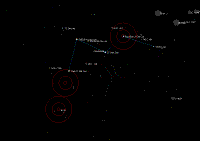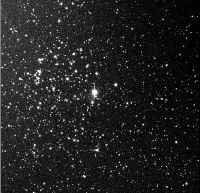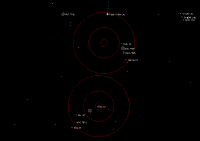M52 (open cluster in Cassiopeia)
120: M52 and M103 Overview
Next up is Cassiopeia, which has two Messier Objects, both open clusters, and both pretty easy to find. The brighter of those two open clusters is M52, shown here.
130: M52
Messier discovered and logged M52 on September 7, 1774. M52 was the only object he added to his list that year. Messier’s log reports the discovery as a
“Cluster of very small stars, mingled with nebulosity, which can be seen only with an achromatic telescope. It was when he observed the Comet which appeared in this year that M. Messier saw this cluster, which was close to the comet on the 7th of September 1774…”
M52 is a relatively rich, tight open cluster, located within the Milky Way. Large telescopes show nearly 200 member stars from 11th magnitude down within a 9 minute circle centered on the core. The distance of M52 is not closely known, with current estimates ranging from 3,000 to 7,000 light years. M52 is easy to locate by using the two brightest stars in Cassiopeia, Shedir and Caph, as pointers. The Astronomical League rates M52 as an “Easy” object in 7X50 binoculars. On a clear night at Bullington, M52 is an easy enough binocular object, although it’s pretty underwhelming. The first time you get it in binoculars, you might not realize you have it because it really doesn’t look like much. The full extent of M52 is about a 13 arcminute circle, or just under half the diameter of the full moon.
140: M52 with Binoculars
To get M52 in your binocular, swing your binocular on a line from Shedir to Caph so that Caph appears at the edge of your field of view. M52 is on that same line on the far edge of your binocular field. On a dark, clear night at Bullington, M52 shows up as a small, faint gray patch of nebulosity. M52 is also pretty easy to find with your Telrad.
150: M52 with Telrad
Pivot your scope on the Shedir—Caph line, centering the scope about 1.5 full Telrad fields beyond Caph. M52 should be visible as a faint gray patch centered in your optical finder. If not, make it so. Like most open clusters, M52 is best viewed at low to moderate power. I generally locate M52 with our widest eyepiece, center it, and then switch to our 14mm Pentax XL, which yields about a ¾ degree FOV in our 10” Dob. If you have a typical 2000mm SCT and 1.25” eyepieces, use the widest one you have. If you have a short-tube refractor, you can use a higher-power eyepiece. A 7mm Plossl or thereabouts will give you a true field of something between ¾ and one degree, which is ideal for this object, and most of the others we’re looking at tonight.



